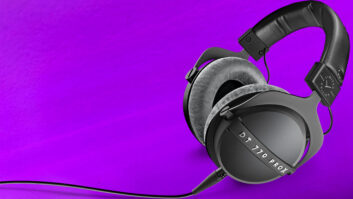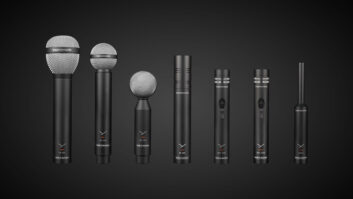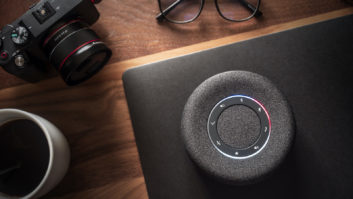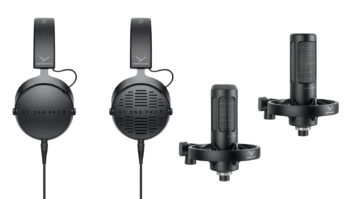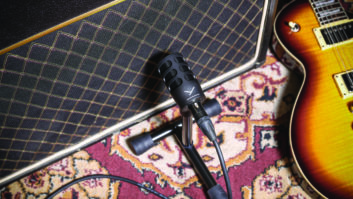
BEYERDYNAMIC MCE 72
June 2007—Beyerdynamic (www.beyerdynamic.com) debuted the MCE 72 PV CAM camera-mountable stereo mic. Based on the consumer MCE 72, the new MCE 72 PV CAM runs on 11- to 52-volt phantom power for a hotter output signal and includes a cable with standard 3-pin XLR outputs.
BEYERDYNAMIC MCE 72
February 2007—Designed for X/Y recording, Beyerdynamic’s MCE 72 ($489) has two cardioid pattern electret condenser capsules mounted ±60 degrees relative to its axis. The MCE 72 uses 5-pin XLR connections, and is powered by a standard 1.5-volt battery with an LED power indicator. Its response is 60 to 20k Hz, and max SPL at 1 kHz is 123 dB. Also for X/Y recording, the MCE 82 ($839) has two cardioid condenser capsules mounted ±45 degrees relative to its axis. Response is 50 to 20k Hz, and max SPL at 1 kHz is 128 dB. The MCE 82’s elastic suspension system suppresses handling and cable noise, and it offers a switchable bass filter. It can be operated with any 12 to 48VDC phantom power or 1.5V battery, and includes an LED battery-power indicator. The MC 833 ($3,699) supports M-S, X/Y and mono recording without an additional matrix. It is equipped with three externally polarized cardioid condenser elements. The middle element supplies the mono signal in M-S applications. The condenser elements to the left and right are used for X/Y recording or can be combined to form a figure-8 polar pattern to supply the side signal. The three capsules can be mechanically adjusted and continuously varied over a wide range.
BEYERDYNAMIC OPUS 89
March 2006—BEYER OPUS 89
Designed for live vocal applications and made to withstand the rigors of touring is the Opus 89 ($279) dynamic mic from beyerdynamic. Using the rare-earth neodymium magnet structure of the company’s TG-X 60, the mic offers fast transient response and excellent feedback rejection.
BEYERDYNAMIC TG-X 80
July 2005—The TG-X 80 dynamic vocal mic ($469) from beyerdynamic is designed for studio performance in live applications where high-SPL vocals are generated and maximum volume before feedback is required. A hypercardioid pattern enables the TG-X 80 to reject sound from the rear by greater than 25 dB (110 degrees, 1 kHz). The mic features a shock-absorbing rubber ring to reduce handling and mechanical noise. The TG-X 80 is available with an on/off switch as the TG-X 81. Frequency response is 30 to 18k Hz and impedance is 280 ohms; magnetic field suppression is >20 dB @ 50 Hz.
BEYERDYNAMIC MCE 91
July 2005—beyerdynamic’s MCE 91 ($649) electret cardioid condenser mic has a gentle rise in response at 2 kHz that facilitates clear, detailed voice reproduction. Its high-SPL capability allows it to be used in a wide range of vocal applications. The mic can be phantom powered using 12 to 48V DC. Frequency response is 30 to 20k Hz with a max. SPL of 139 dB (1 kHz); impedance is 190 ohms.
BEYERDYNAMIC EXPANDS OPUS SERIES
March 2005—Unveiled at NAMM, Beyer expanded its Opus series of vocal and instrument mics with nine models for critical live and studio applications. TO READ THE REVIEW ON THE OPUS 69 AND 81, CLICK HERE.
BEYERDYNAMIC MC930
October 2002—This high-quality, small-diaphragm condenser
features a wide 40-20,000Hz response and 71dB signal-to-noise ratio.
The switchable, 6dB/octave, 250Hz low-cut filter reduces popping noise
when close-miking. With the WS101 windscreen and -15dB switchable
pre-attenuation, the MC 930 can also be used for handheld vocals. Its
cardioid pattern offers high gain-before-feedback and eliminates noise
from the rear, making it suitable for studio, live or contracting
use.
BEYERDYNAMIC MCE494
October 2002—Beyerdynamic has introduced a novel miniature
microphone—the MCE 494, designed to be used by journalists and
conference delegates, and in other dialog-acquisition applications
using semi-pro recording media, PDAs or laptop computers. The mic is
designed to improve the response characteristics significantly over the
microphones fitted internally in such devices, transforming the audio
quality and making it suitable for broadcast.
BEYERDYNAMIC MC 930
July 2002—Unveiled at AES Munich, Beyer’s cardioid MC 930
condenser is optimized for piano, percussion, brass and overheads, and
offers high-end performance at a low price.
BEYERDYNAMIC TGX-80 & MCE 90
June 2001—Beyerdynamic’s TG-X 80 ($469) is a sharp-looking handheld dynamic mic with a fire-engine-red shock absorption ring that helps with structure-borne noise attenuation. Part of the company’s TourGroup Series, the TG-X uses a hypercardioid polar pattern and has a 30 to 18k Hz frequency range. The MCE 90 is a condenser model with cardioid polar pattern and an 139 dB SPL to fit a wide range of singers. Retail is $649.
BEYERDYNAMIC OPUS 81
October 2000—Advanced technology has produced a new breed of
microphones using condenser elements for a wider and more linear
frequency response. The Opus 81 is appropriate for vocals or
instruments onstage or in the studio. The element withstands sound
levels of up to 138 dB without a loss of performance. Artists
preferring a crisp, “transparent” quality will rave about the Opus 81.
Frequency response: 50 to18k Hz; cardioid polar pattern; 12-48V phantom
power. TO READ THE REVIEW, CLICK HERE.
BEYERDYNAMIC OPUS 51
October 2000—The Opus 51 is designed for instrument sound
reinforcement and studio recording. Using its boundary effect, this
microphone captures direct and reflected sounds from an instrument in
perfect balance and at an equal level, taking the guesswork out of
microphone placement. Perfect for use with piano, kick drum or inside a
double bass. Frequency response: 30 to 20k Hz. Semi-spherical polar
pattern and 11-52V phantom power.
